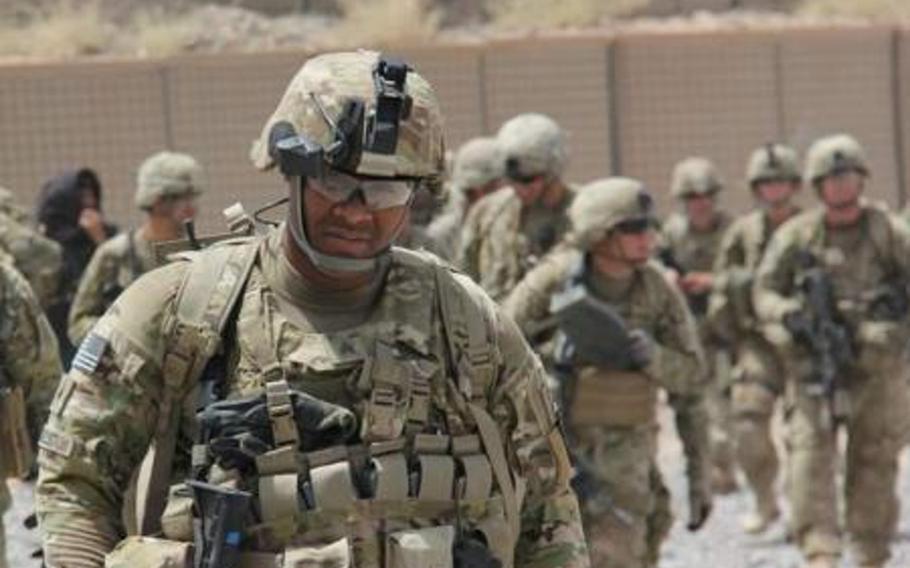
Sgt. Christopher Charleston, then of the 170th Infantry Brigade Combat Team, returns from a mission in Afghanistan in August 2011. At a meeting Oct. 10, 2012, NATO was expected to endorse a plan for the alliance’s post-combat mission. (Mike Newman/DVIDS)
BRUSSELS — Defense Secretary Leon Panetta pressed European allies Wednesday to help fill a gap of more than 50 training teams needed in Afghanistan, as NATO prepares to hand over security responsibility in the country to Afghan forces by the end of 2014.
“I encouraged our fellow ministers to eliminate the shortfalls in providing those teams on the ground,” said Panetta at the conclusion of two days of talks with NATO defense ministers in Brussels, adding that those trainers are a key part of the plan to transfer security to Afghanistan.
A NATO official couldn’t quantify how many trainers are needed — teams can vary in size depending on the nature of the mission — but the official said nearly 90 percent of all training teams in Afghanistan are filled. There are 465 teams up and running, the official said.
An increased number of insider attacks, in which Afghans in security forces uniforms have turned their guns on international troops, should not deter allies from pressing forward, Panetta said.
“We have to remain committed to the principle of ‘in together, out together,’ ” Panetta said. ”We’ve fought too many battles. We’ve spilled too much blood not to finish the job.”
Whether Afghan forces will be ready to assume control isn’t clear, but NATO defense ministers left Brussels ready to commence detailed planning for its post-2014 mission where the focus will be on training and advising Afghan forces.
“This new mission will not be a combat mission,” said Anders Fogh Rasmussen, NATO secretary general. “Planning for that mission is well under way.”
The exact size and configuration of that residual force also is not yet clear. Rasmussen said military commanders will make their recommendations later this year.
At the same time, coalition forces will continue to draw down, though Rasmussen said that does not mean allies are planning to cut and run.
“Drawdowns [and] redeployments will follow an overall plan and will be well-coordinated,” Rasmussen said. “It will not be a rush to the exits.”
On the eve of NATO’s defense ministerial, the Brussels-based International Crisis Group warned in a report that Afghanistan is unprepared to assume full control of security in 2014, and that the withdrawal of NATO forces could lead to civil war.
“There is a real risk that the regime in Kabul could collapse upon NATO’s withdrawal in 2014,” Candace Rondeaux, the International Crisis Group’s senior Afghanistan analyst said. “The Afghan army and police are overwhelmed and underprepared for the transition. Another botched election and resultant unrest would push them to breaking point.”
Rasmussen, however, said steady progress has been made.
“Yes, there will be challenges, but make no mistake, we will see our mission through,” Rasmussen said.
Rasmussen noted that Afghan forces are in the lead in territory where three quarters of the country’s population lives. In Kabul, attacks dropped 17 percent in the past year, he said.
The NATO-led International Security Assistance Force includes 68,000 Americans and 40,000 troops from other countries.
While international support has been key to building an Afghan army from scratch more support is needed in the form of equipment and technology, particularly in the areas of logistics and border control capability, according to Afghan Defense Minister Bismillah Khan Mohammadi.
Still, Mohammadi said his country will be ready to assume security responsibility in 2014.
In a reference to the rising number of insider attacks on NATO forces, Rasmussen also said military commanders have put in place “prudent measures” to make sure “troops have the security they need.”
Currently, most ISAF units have resumed partnering with their Afghan counterparts, “and the ability of Afghan forces to maintain security continues to grow,” Rasmussen said.
Panetta said some of the adopted security measures include adapting partnering operations based on “real-time intelligence” of threats, improved vetting of Afghans and the use of “guardian angels,” which involve U.S. troops standing guard at sensitive meetings.
While combat operations are slated to end in 2014, the new NATO mission approved by the alliance will demand a smaller residual force to continue to work with Afghans in a training and assist capacity. However, if Afghan security forces continue to kill coalition forces, allies could be reluctant to send troops to support the mission. In Afghanistan, U.S. military officials have already acknowledged that so-called green on blue attacks have taken a toll on troop morale.
Insider attacks are a tragic part of every war, Panetta said. Allies should send a signal that such attacks won’t stop international forces from working alongside their Afghan counterparts.
“Whatever tactics the enemy throws at us, we will not allow those tactics to divide us from our Afghan partners,” Panetta said.
Meanwhile, if long-term security is to be achieved, it will require progress in Afghan-led peace talks with the Taliban, Panetta said.
“We believe that the ultimate solution is going to have to include a political settlement and that should be fully pursued,” Panetta said. “We also are continuing to look at opportunities for reconciliation.”